Erica Jurus's Blog, page 2
July 29, 2025
Star Trek: A New Storytelling Chapter
The Trouble with Tribbles. Devil in the Dark. Wolf in the Fold. Catspaw.
Some of the best episodes in the original Star Trek series. I even used one of the titles in my Chaos Roads trilogy, in homage. The original series was one of the most innovative shows to ever appear on television, creating the legend that is the Star Trek franchise today. I get really irritated with modernists who trash the original series, without giving any thought to how remarkable its concepts were in the 1960s, and the powerful legacy it produced.
Most people know the story of its genesis. Gene Roddenberry had a bright idea: to take the drama of Westerns, a popular genre at the time, and transpose it into space. He referred to his idea as a sort of “Wagon Train to the stars”.
The captain of the starship for the pilot was Christopher Pike, in a radical episode called “The Cage”. It was too much for NBC, who deemed it “too cerebral”. They were interested in the general story, however, and the pilot was reworked with a new, young captain, James T. Kirk, a heroic leader modelled after the daring ship captains who used to sail the high seas on earth. The only character retained from “The Cage” was a fellow with pointy ears and green blood, a Vulcan named Mr. Spock (his first name was never revealed).
Each episode was a stand-alone story, following the mission of the Enterprise, Starfleet’s flag ship, to “explore strange new worlds, to seek out new life and new civilizations, to boldly go where no man has gone before”. The episodes were penned by different sci-fi writers, and used the vehicle of science fiction to explore complex topics: racism and innate prejudices, suspicion and fear of what we don’t know, oppression and slavery, violent entertainment, the corruption of power, and much more. And while the sets and special effects are certainly dated now, I still love them because they allowed our imaginations to extrapolate beyond them. But most of all, I was fascinated with the worlds and civilizations that the crew of the Enterprise encountered.
Captain Christopher Pike and “The Cage” were resurrected in a brilliant two-part Season 1 episode called “The Menagerie”, when Spock mysteriously commits mutiny to help his now completely disabled former boss, Pike, by kidnapping him and taking the ship to the strictly forbidden planet Talos IV, an action that will certainly result in the court-martial of Spock. What follows is one of the most suspenseful and imaginative plots ever televised.
I was delighted when the Star Trek movies and various series came out, some of which I’ve loved, others not so much. From talking to others, it seems we Trekkers each have our own preferences. But to be honest, for me, none of the ensuing offerings ever captured the magic of the original, and eventually I felt we’d reached saturation point. I stopped tuning into anything new.
Until a few days ago, when a description of one of the newer iterations, Star Trek: Brave New Worlds, kinda grabbed my interest. This series is the story of Captain Pike ten years before the accident that resulted in his permanent prison inside a life-sustaining machine. He’s foreseen the accident, but believes it will be the death of him, and isn’t certain he’s still fit for command. But he’s ordered back into duty, to rescue the same female first officer from “The Cage”, along with a young Spock, a very young Lt. Uhura straight out of cadet school, a crusty chief engineer, a feisty young Nurse Chapel, and other pretty cool characters.
I’ve loved every episode so far. They remind me very much of what made the original series so special for me: great ensemble cast, wonderful cinematography and well-crafted stories as the Enterprise before Kirk embarks on the very first mission to explore those strange new worlds. There are some terrifying villains out there, to be sure, as well as personal demons that some of the crew carry around with them, as the show bridges newer filming techniques with the older Federation technologies in a spell-binding fusion.
I’m tickled to have discovered, even if a bit late into the series, a world of Star Trek that interests me again, because I have so missed the wonder of the first one (even though I enjoy the reruns). Maybe the title of one of these new episodes will even make it into one of my upcoming novels 
July 22, 2025
Strange writer research
“You’re researching what?”
“Well,” I said to hubby, “I have this idea stuck in my head about the librarians on the archive planet of Jebeha being lizard-like.”
He shrugged. He’s used to the weird things that come out of my brain.
Why lizards? I don’t know — I just go with my gut on a lot of these things. But then I had to determine whether lizards might actually be feasible as archivists/librarians.
It turns out they would, rather.
On a planet that serves as a galactic archive, media would need to be stored and preserved in various formats, to accommodate the needs of a variety of species, not just humans. And lizards have a number of different sensory organs in their biological repertoire.
They have excellent eyesight, useful for finding prey and judging the distance to it. Some lizard species, like chameleons, can move each eye independently of the other. Some lizards even have a light-sensing organ on top of their heads, called a parietal eye. It can detect changes in movement and light/shadow. Many lizards can see in colour, a useful method of identification and classification.
All lizards have a specialized olfactory system in their tongues to detect odours. They discern clues about the environment, possible mates, and the presence of predators.
They have eardrums and can hear, which theoretically would make them able to understand the Galactic language in my novels.
Lizards are remarkably adaptable, living everywhere except Antarctica.
Now, combine that with a more-or-less bipedal form with hands that can grasp and manipulate objects, and, if you’ll pardon the pun, a ‘dry’ sense of humour, and the lizard-like monks of Jebeha were born!
The question of the oddest thing I’ve ever conducted research on came up on an ‘about me’ form for an event I’m participating in mid-September, the dReadCon Horror and Dark Fiction Convention in Burlington, Ontario. I had to think about it for a minute — I’ve completed a lot of research on a cornucopia of subjects — but the lizard-thing beat them all out in the end.

You can find my complete write-up on the Blog:
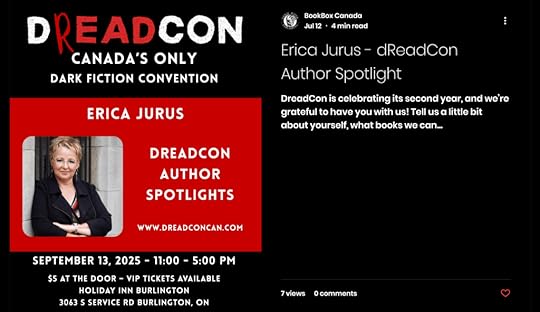
I hope you find it entertaining. I’m really looking forward to this convention — right up my darkened alley, so to speak, and for all lovers of a little shade and shadow. I’ll be offering special Spooky Reading Kit bundles, with signed copies of the book(s), bookmark, a Roads Troublemaker mug, a Chaos Roads coaster, a 10-bag box of my favourite tea, 10 Chaos Roads napkins and a pouch of tea treats. Everything you need for a spooky night of reading time! More info to come!
 Saucy green lizard in the Amazon jungle – by E. Jurus, all rights reserved
Saucy green lizard in the Amazon jungle – by E. Jurus, all rights reserved
July 15, 2025
The salty path of veracity
Tis the season for publishing debacles, apparently. Just a few weeks ago the story broke that a list of great books for summer reading, published by major newspapers, contained books that didn’t actually exist. The writer had used AI to do the research, and it had made things up.
This week, the author of a publishing sensation, The Salt Path, had her success blow up in her face when a British newspaper, The Observer, a British newspaper, wrote an expose of alleged untruths in Raynor Winn’s memoir/tale of hope.
What the heck happened?
A memoir is defined as a narrative, written from the perspective of the author’s personal memories, about an important part of their life. “The assertions made in the work are thus understood to be factual.” (Wikipedia, subject: Memoir)
In the writing/publishing world, it’s understood that the story is seen through the lens of the author’s memory, and of course none of us (except Sheldon Cooper on The Big Bang Theory) can recall our lives in perfect detail. I’ve had many requests to write a memoir of the adventure- and sometimes chaos-filled travels of my hubby and I, and I wouldn’t be able to supply everything exactly as it happened, even with a pretty good memory. I’d be recounting the highlights, the nuances, the emotions (such as the ‘are you kidding me?’ feeling when learning over dinner the first night of our honeymoon that a hurricane was on the way in two days).
But I would strive for as much truth as I could bring to it. And our story wouldn’t carry any emotionally charged message, beyond that: our world is an amazing place and we learn so much by travelling it, no plans ever run perfectly, and our motto, after a lot of zaniness, would be “Keep Calm and Maintain a Sense of Humour”. (If no one’s ever copyrighted that one, it’s mine now ©)
I haven’t read The Salt Path – in fact, I wasn’t aware of its existence before this new scandal made all the literary news – but it carries a significant message of triumph over unfair adversity, which appeals to all of us. However, according to the substantial research conducted by The Observer, the basic elements of the adversities that drove writer Raynor Winn and her husband Moth to spend months hiking the South West Coast Path of England with no money and whatever they could fit into two small backpacks are patently untrue.
It’s an interesting publishing story. This is what I’ve learned so far:
The book has a visually captivating abstract cover, very atmospheric. The names of the author and her husband are engaging and ‘cool’: Raynor and Moth. (I have to admit that my first reaction was who names their child Moth?)
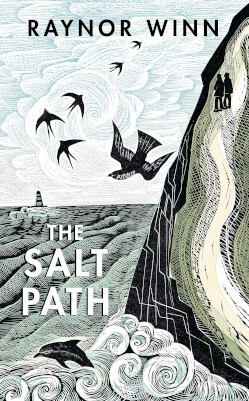 The Salt Path. book cover, By Raynor Winn – https://lgslibrary.com/blog/costa-book-awards-2018-shortlists/, Fair use, https://en.wikipedia.org/w/index.php?curid=76756965
The Salt Path. book cover, By Raynor Winn – https://lgslibrary.com/blog/costa-book-awards-2018-shortlists/, Fair use, https://en.wikipedia.org/w/index.php?curid=76756965Raynor writes of losing a beautifully bucolic country house and their livelihood from it, due to a bad investment with a friend. Based on the sampler I read on Amazon, the book is written to elicit a lot of pathos for their plight, with a great deal of detail about the charms of the existence being ripped away from them through no fault of their own.
At the same time, “Moth” receives a devastating diagnosis of a terminal disease, corticobasal degeneration. The standard prognosis is 6 to 8 years, and he’s already lived through 6 of those seeing different doctors. According to Sally, they’re told he must have a slower version.
Feeling they have no other options (Tim has a brother, who apparently won’t help them out), they gather up whatever belongings and camping supplies will fit into light backpacks, as Tim is in poor shape and can’t carry much. Inspired by a book called Five Hundred Mile Walkies, they decide to spend whatever time they have left together living “wild” as they hike the path that circles the coast of Devonshire.
Sally apparently wrote a memoir of the tribulations of homelessness, the triumph of the human spirit and the almost-miraculous restoration of her husband’s health.
Original reviewer blurbs have included:
‘A beautiful, thoughtful, lyrical story of homelessness, human strength and endurance’ Guardian
‘A tale of triumph: of hope over despair; of love over everything’ Sunday Times
‘Mesmerising. It is one of the most uplifting, inspiring books that I’ve ever read’
‘The most inspirational book of this year’ The Times
‘Luminescent. A literary phenomenon’ Mail on Sunday
‘This is what you need right now to muster hope and resilience . . . a beautiful story and a reminder that humans can endure adversity’ Stylist
The memoir has sold over a million copies, and been turned into a movie starring Gillian Anderson and Jason Isaacs as the ‘Winns’. There are photos of the movie stars and the couple sitting picturesquely on grassy hillsides.
Here’s what, according to The Observer’s investigations, actually happened:
The couple’s actual names are Sally and Tim Walker. In the sampler of the book on Amazon, throughout the narrative the couple call each other “Ray” and “Moth”.
From testimony by the actual party involved, Sally and Tim defrauded the friend’s company of about £64,000. They were then given a loan by one of Tim’s relatives, which they failed to repay, and the relative then turned the loan over to two other parties. The case went to court and the Walkers lost the judgment. There’s more to the story, but their property was later seized under those circumstances.
There have also been questions about the truth of Tim’s illness. He was treated for that condition, but according to experts it isn’t following the usual progression and shortened lifespan, and the remarkable recovery couldn’t have happened either.
Readers are by and large furious. Comments online have already convicted Sally, from what I’m seeing, such as:
“…fake memoirs are nothing new. Doesn’t make this latest one any less scummy, though.” (on Redditt)
“They presented themselves as tragic victims of their own generosity, but they actually lost their house because they couldn’t pay back the 60 grand she nicked from her job?” (on Redditt)
“I didn’t like her when I read the book. I couldn’t get over her selfishness and lack of shame for all the petty crimes like not paying for the use of camp site facilities, as if other people’s livelihoods don’t matter…and did she ever go back and pay these debts after she became rich? At the end someone is fooled enough to give them a property too! I feel vindicated now in my opinion of her. What’s a campsite fee to someone who has embezzled £64,000? Not to mention a fake lottery to win their house before it was repossessed!” (comment on a reviewer’s website)
“The Book Promotion Industry is part of the problem.” (on Redditt)
Of course the publishers were heavily romanticizing and promoting The Salt Path. That is their job, after all. As a self-published author I do the same. However, my novels are works of fiction.
Why do authors pen ‘memoirs’ that are bogus? So that they can say they’ve published a book, I assume, and enjoy any resultant fame and profit from it.
In 1997 a book titled Misha: A Mémoire of the Holocaust Years, was written by a woman named Misha Defonseca, who supposedly, as a child whose Jewish parents were taken by the Nazis, fled across Europe on foot and was adopted by a wolf pack. Well, it turned out that her real name is Monique De Wael, she’s not Jewish, and the whole thing was a ‘pack’ of lies. The book was another bestseller made into a movie, but after the truth came out she was ordered to pay $22.5 million back to her publisher. Her comments were that “it’s not the true reality, but it is my reality”, “there are times when I find it difficult to differentiate between reality and my inner world” (no kidding) and that “ever since I can remember, I felt Jewish.”
Memoirs are meant to be inspiring, and readers reasonably feel cheated and betrayed if they find out the story wasn’t genuine. Readers of James Frey’s ostensible drug addiction memoir, A Million Pieces, eventually sued the publisher, Random House, claiming they were defrauded. A settlement was reached in which the publishing house agreed to pay out a total of up to $2.35m.
But how are publishers to forestall publication of these kinds of books?
It seems that memoirs are fact-checked – to a limited extent – with a publisher looking into an author’s background and story. But apparently publishers don’t have dedicated departments for this, and the fact-checking isn’t the main focus of the editing process. The primary concern is that a book doesn’t contain anything that might lead to a law suit (which I would read as ‘libellous’). The author signs a contract with the publisher pledging the integrity of the material to the ‘best of their knowledge and belief’. If problems later arise, the publisher can then cancel the author’s contract, and it’s usually the author’s reputation that sustains damage.
I have to wonder who decided to create the aliases for the author and her husband – was it the author herself, to distance herself from her past, or the publisher to provide a more marketable name? For me, that was a red flag right off the bat. If you’re publishing an inspiring memoir, why do it under an assumed name?
It’s a literary nightmare. The PSPA Charity in the UK related to the disease has chosen to terminate its association with the couple. The publisher, Penguin House, isn’t saying much other than that the publication of ‘Winn’s’ next book is being delayed “to support the author”.
The author has stated that The Observer’s allegations are false and that she’s seeking legal counsel, and the newspaper has issued a rebuttal to that.
So what happens now? I suppose the courts will again decide the “truth”. In the meantime, the author has become wealthy and will continue to earn royalties by anyone else who might be curious enough to buy the scandalized book, or her two subsequent books. Do all the reviewers who raved about the book feel silly? Are the movie’s producers regretful? (I’m guessing not for the last one, but I haven’t seen the stats).
I don’t know how much of The Salt Path is true and how much isn’t, but any future books by the author will certainly come out under a cloud, if at all.
I suppose my take on all of this is that as authors we have a duty to write from the heart, not the pocketbook. I haven’t been able to find out what prompted The Observer to begin an investigation into The Salt Path in the first place, but it’s a good lesson for memoirists: when you expose a turning point in your life to the general public, it should be worth its ‘salt’.
July 8, 2025
Thick fun in the summertime
I read an article recently that piqued my interest. It seems there’s a very recent trend to dive into “big, thick books” this summer, and the writer dissected why that might be. And since I write big, thick books, I thought about my own attraction to that type of novel.
If you’ve been letting your reading lapse, researchers have discovered two fantastic reasons to revive it:
In a study by Yale University of over 5,000 participants, it was shown that people 50 years of age and older who read books regularly have an increased survival rate of 20% over the ensuing twelve years! That’s good enough for me Reading, along with other brain-stimulating activities like doing puzzles and playing games, prevents long-term cognitive decline in older people.
Reading, along with other brain-stimulating activities like doing puzzles and playing games, prevents long-term cognitive decline in older people.Having watched several people who I know well, all now over the age of 50 in varying degrees, I’ve seen firsthand both extremes – those who are showing decline even in their seventies, and those in their eighties and nineties who have kept as sharp as possible.
So what happens to writers of lengthy tomes  ? Hopefully even more benefits.
? Hopefully even more benefits.
I’ve always loved settling in to read a good, hearty book, as I like to think of them. Actually, I like most things that could be described as hearty – a great bread like sourdough that you can really sink your teeth into; a rousing, robust cup of tea; a warming, tummy-filling meal when the temperatures drop in autumn.
Novels with several hundred pages promise a richness that a short fluff book just can’t deliver. I read Gone With the Wind, my mom’s favourite novel (and movie), when I was nine. And Lord of the Rings when I was thirteen. Longer books, the kind that are best turned into series rather than movies, have the room to include details I want to read – background, scenery, mythology, and enough action to really bring the story to life.
According to the article, “People are looking to heal their attention spans, to be absorbed in something long term again.” That sounds like a very worthy goal in today’s society, where our attention is so fractured and clipped. There’s something magical about curling up in a chair or a favourite corner of a couch, making a cup of tea, opening a great book, and settling in for a good read for a couple of hours. We need to take that kind of break from the world. I don’t know why our society likes to engage in ‘doomscrolling’ (‘excessively consuming negative news and information online’) – I’d much rather lose myself in a wonderful adventure for a while, something that makes me smile, gasp, clutch the pages, and wish I didn’t have to close the book at the end.
And how much better our cognitive improvement must be when we engage with a detailed plot that makes us clasp its contents together in our brain, trying to figure out the mystery of who’s to be trusted and who’s secretly nefarious, how will the heroine/hero survive the many-layered odds.
There are plenty of hearty books out there, and I’d like to humbly recommend my own 600-odd page novels if you’d like a little creepiness in your summer – perfect if you’re celebrating Summerween, another hot trend this year (instead of Christmas in July, it’s Halloween in July). They’re great supernatural thrillers, with plenty of adventure and strange things in the shadows. If you start the first one now, you can get to the third and final by October, just in time for the real Halloween!
July 1, 2025
Happy to be Canadian
I hope all Canadians are enjoying our national holiday today. While we’re not highly demonstrative, we can be roused to defend our beautiful country, our freedoms, our culture. Here’s to being proud citizens of Canada! (photo of a Canadian flag fluttering in the breeze on a cruise of the 1000 Islands, taken by me and all rights reserved)
June 25, 2025
Sometimes humanity restores your faith in it
This post is a day late because my main laptop has refused to boot up again – it’s going back to the shop tomorrow. I’m working on an older, slower laptop, but at least I have the backup. So this story is a short one:
Yesterday I stupidly left a shopping bag with a new black jacket for my upcoming appearances in my grocery shopping cart. I’d stowed it on the lower basket, and completely forgot to remove it along with my bags of groceries when I transferred them to our truck. Didn’t realize all through dinner at a restaurant afterward – not until we arrived home.
Crap! I jumped in my car and headed back across town to the grocery store at our big mall. I’d already prepared myself that the clothing bag might have disappeared into someone’s unscrupulous hands, but I had some hope or I wouldn’t have bothered making the trek at 8pm.
I talked to two of the grocery store staff, who didn’t think they’d seen such a bag – but, on a search through the back room in Customer Service, lo and behold, there it was!
All three of us were gratefully surprised that someone had found the bag, whether it was another shopper or the boy that sorts through the carts at the end of the day and gathers them up for storage, and turned it in. No matter how dismayed we may get at the state of the world, even on a local front, humanity continues to restore our faith on occasion.
June 17, 2025
Tea and a Mystery: The Great Brownstone Detective
Saul and I handled the breakfast problem, and for lunch we had cold cuts, including the sturgeon, which had been passed as edible, two bottles of champagne, and five kinds of cheese. The Doorbell Rang (A Nero Wolfe Mystery Book 41)
If you’re going to play hermit for a day and escape into the world of detective Nero Wolfe, bring an appetite. Because the great genius who solves murky murders, largely from the leather chair in his office inside his generously-sized brownstone home in New York City of the 1940s/1950s, is the old-fashioned definition of a gourmand. As in someone who ‘enjoys eating and drinking, with a particular appreciation for good food and fine dining’.
I rarely leave my house. I do like it here. I would be an idiot to leave this chair, made to fit me —. Nero Wolfe in
“Before I Die” (1947), chapter 2
Nero Wolfe rarely leaves his brownstone, and when he does it’s generally under duress. Author Rex Stout described him as weighing a seventh of a ton, with a high forehead, full but not pudgy cheeks, full lips that might purse in and out when he’s considering a problem, a complexion that can become florid after one of his legendary meals. Since his house, which he shares with his energetic factotum Archie Goodwin and his Swiss chef, Fritz, is largely his entire world, he’s surrounded himself with luxury, and he commands high fees in order to fund his lifestyle.
Archie Goodwin, a sharp-eyed detective who’s Wolfe’s right hand man, does all the leg work, and Fritz supplies Wolfe with the gourmet wellness to fuel his brain. Wolfe is highly opinionated about his food and often argues with his chef about the preparation.
As part of Wolfe’s happy nesting, he has a strict daily schedule:
Breakfast is in his room, in bed, wearing his signature yellow pajamasFrom 9am to 11am he tends to his prized orchids in the greenhouse on the top floor of the brownstoneLunch takes place at 1pmFrom 4pm to 6pm he returns to his orchidsDinner is at 7pm sharpClient meetings largely take place in the mornings between orchid time and lunch, or in the evenings after dinnerMeal times and orchid times are sacrosanct, and heaven help anyone who tries to mess with those.
Rex Stout served in the U.S Navy, followed by a variety of jobs. He began writing short stories in his mid-twenties, selling mainly to pulp magazines. He published his first novel in 1929, and in the 1930s he tried his hand at detective fiction, about a rotund, methodical, and brilliant detective and his assistant. The Nero Wolfe novels were a success, and characterized the rest of Stout’s life. He published at least one story a year, to make 47 novels in total. We have all of them, downloaded as ebooks to save shelf space in our already overflowing library.
For my hubby and me, what defines the Nero Wolfe stories the most is the period ambience. It’s what makes the books, and the brilliant 2001-2002 television series on A&E, featuring Maury Chaykin as the crusty Wolfe, and Timothy Hutton as the charming Goodwin, so effective an indulgence and escape. Watching the series is like having a plate of gourmet chocolates with a glass of port – rich, full of flavour, and soul-gratifying. It’s rare that a filmed version surpasses the original books, but this series achieved it: a complete immersion into the days of gritty detective stories flush with the style of the feisty decades between the Roaring Twenties and WW2.
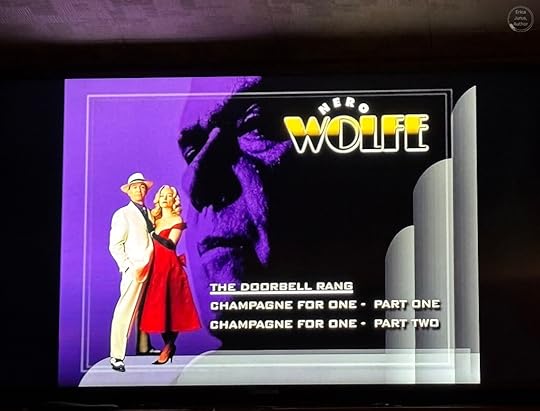 One of the Nero Wolfe Mystery DVDS on our television – by E. Jurus, all rights reserved
One of the Nero Wolfe Mystery DVDS on our television – by E. Jurus, all rights reservedThe mysteries are fun, but for me they take a back seat to the lives of Wolfe, Goodwin, Fritz, Wolfe’s orchidist Theodore Horstmann (who doesn’t make an appearance in the television series), the irascible Inspector Cramer (chomping on his cigar) and his sarcastic sidekick Sergeant Purley Stebbins, Wolfe’s efficient additional operatives (Saul Panzer, Fred Durkin and Orrie Cather), and various other entertaining characters.
Wolfe’s brownstone, somewhere on the south side of West 35th Street, is a central character of the novels – so much so that fans have posted online diagrams of its layout. The television series did a superb job of recreating it, with hundreds of tiny details in the background.
Each novel is replete with references to food, and while some of the meals may seem a little dodgy by our standards (like squirrel, and shad roe, which I’ve looked up and would, frankly, make me lose my cookies), they will probably make you want to set a table with china and flowers and create something delicious to eat. Here’s a simple description of one of Wolfe’s breakfasts by Archie, the ever-present and cheeky narrator:
I descended a flight to Wolfe’s room, tapped on the door, and entered. He was in bed, propped up against three pillows, just ready to attack the provender on the breakfast table which straddled his mountainous ridge under the black silk coverlet. There was orange juice eggs au beurre noir, two slices of broiled Georgia ham, hashed brown potatoes, hot blueberry muffins, and a pot of steaming cocoa. Over My Dead Body
Wolfe even fusses over producing acceptable scrambled eggs in The Mother Hunt. I’ve made his version, and it is superb – incredibly light and fluffy clouds of eggs. You can find the recipe online on the Scribd site.
The novels themselves can be a bit challenging to read from the perspective of a different century. Stout’s language reflects the attitudes of the time period, as politically-incorrect and insensitive as it appears to us now, but I think if you can set that aside you’ll really enjoy the time travel. Stout also wrote Wolfe as quite disparaging of women, although he hinted at some reasons for that in Wolfe’s much more active past as a young man in Montenegro. But I do recommend watching the television series if you’re willing to rent or buy it on Amazon. We have the complete set on DVD, and we’ve lost count of the number of times we’ve binge-watched. Our only regret is that the series began to lose ground in 2002 to other programming and more episodes weren’t made.
You might also be able to find The Nero Wolfe Cookbook, a compilation of recipes from the books published by Rex Stout himself in 1973, in your local library. Copies of it are available on Amazon. Create a simple, delicious repast of cheeses and cold cuts with a glass of champagne or a cup of tea, or something fuller from the cookbook, put on episodes from the filmed series, and settle in for a cozy evening of beautiful dames, slick detectives, stylish cars and jazzy glamour.
June 10, 2025
Never mind looks that can kill, how about books that will?
No, this is not an intro to a horror movie, although I’ve just given myself an idea!
It’s been a while since we’ve taken a look at colours and how intimately they’re tied to life, literature and storytelling. Well, the perils of the colour green are in the news.
For a species that’s supposed to be the smartest on the planet, we humans can be remarkably stupid in our pursuit of fashion and décor.
The quest to bring vivid colours to artwork, clothing, wallpaper and even book covers became entangled with chemistry, and the end results were lethal.
In 1775 a pharmaceutical chemist named Carl Wilhelm Scheele played around with a solution of sodium carbonate, commonly known as washing soda or soda ash. He slowly added arsenious oxide, which contained – guess what? Arsenic. After putting that into a solution of copper sulfate, it produced a pretty green result, which he named after himself: Scheele’s Green.
It was more brilliant and durable than current green tints, and became an extremely popular colour to add to just about anything – textiles, wallpapers, paints, candles, bookbindings, children’s toys and even some sweets.
There was another popular green pigment, created in 1814, called Paris green, or Emerald green, which had a pretty bluish undertone.
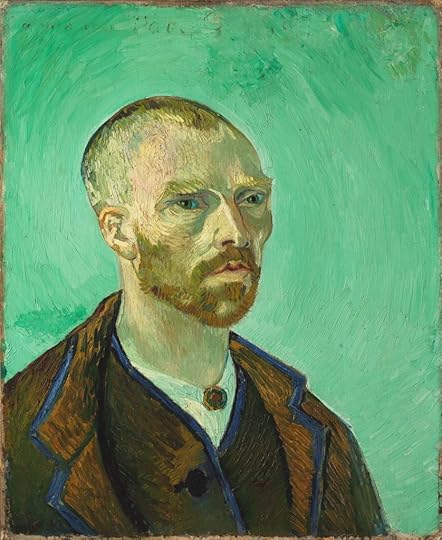 Vincent van Gogh, Self-Portrait (Dedicated to Paul Gauguin), September, 1888. The vivid green background has an undercoat of Paris green. You have to wonder whether use of this pigment contributed to the artist’s psychological difficulties. By Vincent van Gogh – 1. Web Museum, (file)2. Google Art Project, Public Domain, https://commons.wikimedia.org/w/index.php?curid=9857
Vincent van Gogh, Self-Portrait (Dedicated to Paul Gauguin), September, 1888. The vivid green background has an undercoat of Paris green. You have to wonder whether use of this pigment contributed to the artist’s psychological difficulties. By Vincent van Gogh – 1. Web Museum, (file)2. Google Art Project, Public Domain, https://commons.wikimedia.org/w/index.php?curid=9857 Although the toxicity of arsenic compounds wasn’t generally well known at the time, someone figured it out – they began making insecticides with both pigments. Paris green was officially the first chemical insecticide made. It was even dangerous to manufacture.
But the vibrancy of the colours was apparently too good to resist, and green-tinted articles began showing up everywhere.
Even designer-artist William Morris, as the heir to a copper mine (which conveniently produced arsenic dust as a byproduct), used these greens in his wallpaper. Although as an activist he campaigned for safer working conditions for textile manufacturers, there wasn’t an organic dye that could replicate the beautiful greens of the arsenic/copper based pigments, and he refused to believe claims that they could be dangerous, even when doctors told him flat out that his miners were suffering from arsenic poisoning. Morris claimed they “were bitten by witch fever”, as in, making it up.
 Daisy wallpaper designed by William Morris. https://www.metmuseum.org/art/collection/search/384017, public domain
Daisy wallpaper designed by William Morris. https://www.metmuseum.org/art/collection/search/384017, public domainBut soon there were reports of ladies in green gowns passing out, children wasting away in rooms painted green, and newspaper printers being overcome by toxic vapours. Some European countries began banning these arsenic-containing tints, but use of them continued for several decades, until a young maid tasked with dusting artificial greenery died from arsenic poisoning. The newspapers reported her illness in great detail, including the fact that her eyes and fingernails had turned green. It must have been a horrible death.
Throughout the 19th century, Paris green and similar arsenic pigments were used in books in multiple ways – cloth coverings, decorations and interior illustrations. And many of these antique, and highly toxic books, still exist in collections around the world.
In 2019 two staff members of the Winterthur Museum, Garden and Library in Delaware found a book in one of its own collections that contained Paris green. Now if you still think being a librarian is a stuffy job, check this out.
Melissa Tedone, head of library materials conservation at Winterthur, was working on a copy of the 1857 book Rustic Adornments for Homes and Taste. She noticed, under a microscope, that bits of the green pigment-dyed starch used to strengthen the bookcloth were starting to flake off.
Bookcloths became a less expensive alternative to leather bindings in the mid-1800s. The advantage of the cloth is that it allowed for some beautiful tinting, and one of the most popular colours was Paris green. It’s been estimated that in twenty short years, before the colour went out of fashion, tens of thousands of books were made with it.
Melissa provided samples of her green flakes to the museum’s laboratory head, who a cool machine called an x-ray fluorescence spectrometer to examine the flakes, and discovered that they contained copper and arsenic.
The Paris green bookcloths could cause arsenic poisoning in people who handle them often, i.e. librarians and researchers. Paris green flakes into a dust that’s invisible to the naked eye. There are a number of other toxic substances used in pigments, including lead and mercury, that the Project has also identified.
The Poison Book Project was created to identify toxic books in other institutions so that librarians there could start protecting anyone who might handle them. Its research team has developed an emerald green color swatch bookmark, which doesn’t offer definitive proof of the presence of Paris/Emerald green in a book, but provides a visual guide to help either private individuals or institutions to narrow down whether it’s likely in one or more of their books. According to the project’s website, there’s currently a long waitlist for the free bookmarks.
The University of St. Andrews has recently made the news for inventing a gadget that can quickly identify arsenic in green-covered books from the 19th Century. A significant issue for many institutions has been that they haven’t had the resources to test or have tested any such book in their collections. As a result, those books are being restricted from use. The researchers at St. Andrews wanted a practical solution for surveying the thousands of historic books in their collection.
Using a spectrometer that detects minerals in rocks, they were able to have their physics department create a portable, non-destructive instrument that flashes red if a book is poisonous. It’s already been used to survey the thousands of books in the St Andrews collections and in the National Library of Scotland.
The toxic antique books will become increasingly dangerous as they age and deteriorate, and the team hope to share their design with other institutions around the world, to allow for identification, safe storage, and putting precautions in place for patrons to be able to continue to enjoy them.
As always, the moral of the story is that health and safety comes before art. But humans have a history of not learning from our mistakes. If you happen to have an antique book in your home with a vivid green cloth cover, you might want to bag it up and have it checked out, because in that case you’d absolutely want to judge the book by its cover.
June 3, 2025
A Convention to Remember
What happens when you combine elements of popular culture across more than 200,000 square feet? Magic — as much for the vendors as for the visitors!
The convention ran from Friday, May 30 to Sunday, June 1. Vendors were able to bring their stuff in and set up more-or-less all day on Thursday. My hubby and I were kind-of dreading that. We packed everything into the truck that morning (a snug fit — if we ever do a larger convention, we’ll need a bigger truck!), with visions of long line-ups of vehicles at the loading docks of the Niagara Falls Convention Centre dancing in our heads.
Happily, vendors arrived in small groups, so we were able to park near the docks and use our carts to wheel things up the ramp and into the main hall in short order. My corner booth was a little more snug then we’d expected, so we performed a bit of tweaking to make the most of the space while staying within the chalk markings on the floor.
 Bringing everything in
Bringing everything in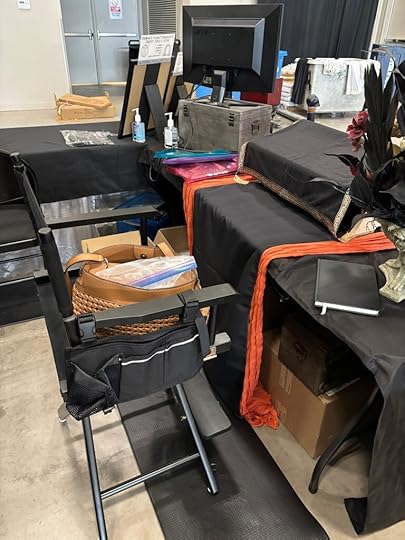 Arranging and rearranging
Arranging and rearranging The final look
The final lookIt took only about an hour from load-in to finished booth, apart from my hubby’s geek-out moment when he spotted his first ‘live’ Dalek down the aisle at the large Dr. Who Society booth and disappeared in that direction for a while.
After that, we were free to wander the show floor and check out the massive Optimus Prime replica truck, the Bumblebee Camaro, the Cheech and Chong Love Machine, and a chocolate & fudge vendor pouring out all their delectable goods into plexiglass bins. I didn’t turn down some free samples — smart move on their part, as we were instant converts.
 The huge replica Optimus Prime truck
The huge replica Optimus Prime truck Bumblebee Camaro – automatic trannie, sadly
Bumblebee Camaro – automatic trannie, sadly The fuzz-filled Love Machine
The fuzz-filled Love Machine We bought a lot of these chocolates!
We bought a lot of these chocolates!On opening day, we had to be ready to go by noon, when a couple of thousand school kids came romping through as part of the convention’s first ever Educon. It looked like they were having a great time, having already spent time in a slew of other special activities. When they left for their buses at 1:00, we had time to grab some lunch and hit the washrooms before the VIP visitors began to arrive at 2:30.
Over the three days of the convention, we met all kinds of wonderful people, some fantastic cosplay outfits, and regular visits or pass-bys by the special costumed guests, who got prepped in the service hallways just on the other side of the wall from my booth. We got to know the fellow who played Bumblebee Transformer, Iron Man, and Master Chief quite well, as well as the TMNT performers from Buffalo. Watching the stream of cosplayers past my booth was great fun — I chatted with a lot of them. The Daleks all had real people inside — I watched them being ‘assembled’ one morning — and they roamed freely around the aisles. One of them came by on Sunday to insist that it COULD survive my Chaos Roads (a quiz playing on my computer monitor) because, of course, it’s a Dalek! When I politely disagreed, it promised to bring an army and ‘analyze’ the situation.
I was busy at my booth and didn’t have time to see many of the celebrities, but I did make a point of seeing Robert Englund (Freddy Kruger!) signing autographs with, as you might imagine, a long line (Freddy striped sweaters were the most popular costume at the Con). I was also able to say hello to Tim Rozon, my favourite actor from two of my all-time favourite series, Wynonna Earp and the currently-running SurrealEstate. He was very gracious and friendly (and even better-looking in person).
Quite a few people were interested in my novels — one couple even bought a complete set for each of them! I also received a lot of compliments about the look of my booth, and one fellow in the publishing industry was really jazzed about the look of my books, from cover design to interior layout and readability. Great feedback to have!
My best sales were on Sunday, interestingly enough, and when we’ve gathered our thoughts we’ll sit and analyze the costs vs sales, but in a typical turn of life, we were notified on Sunday afternoon that a family member had been rushed to the hospital for Emergency Surgery. The security guards outside were kind enough to let us part close to the ramp so that we could pack up quickly at 3:30 when the convention was winding down, and we were able to get to the hospital in good time. We’ve been a little preoccupied ever since, but I wanted to share this post with you.
Here’s a selection of my favourite memories:
 Fantastic Maleficent & Aurora
Fantastic Maleficent & Aurora Final Destination Bloodlines sneak peek – that had to hurt!
Final Destination Bloodlines sneak peek – that had to hurt!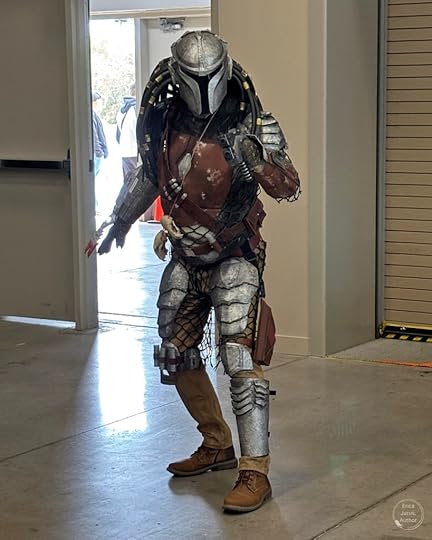 Predator was willing to strike a few poses
Predator was willing to strike a few poses A snarky Grinch chatting with us
A snarky Grinch chatting with us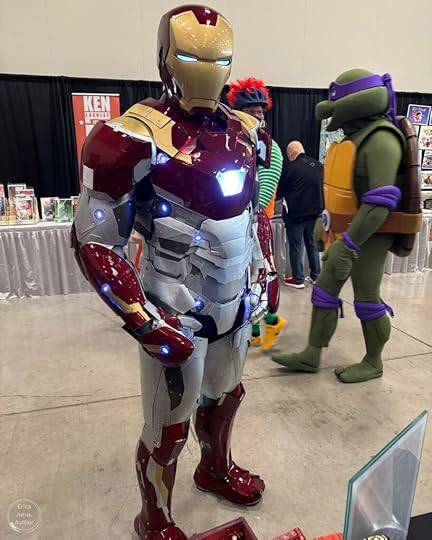 Amazing Iron Man costume, along with one of the Heroes on the Half Shell
Amazing Iron Man costume, along with one of the Heroes on the Half Shell Same fellow as a towering Bumblebee
Same fellow as a towering Bumblebee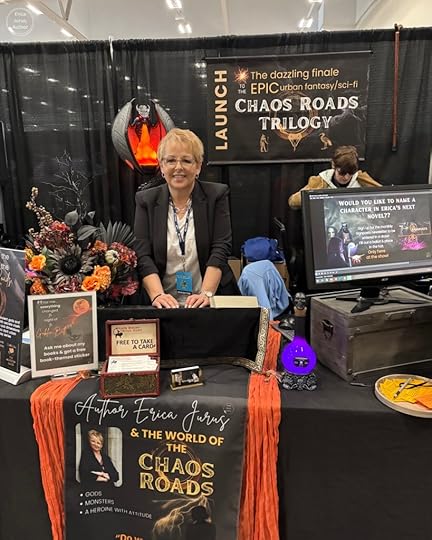 At my booth, with Patti in the background
At my booth, with Patti in the background The Dalek comes to discuss/threaten
The Dalek comes to discuss/threaten Gorgeous laser-etched charcuterie board with my Map of Llithfaen on it!
Gorgeous laser-etched charcuterie board with my Map of Llithfaen on it!Despite the long hours, sore feet and general tiredness, we had a blast! The people in the booths beside and behind us were super-nice; we shop-talked quite a bit during slow times. Special thanks to my hubby, who’s been my rock and brilliant advisor during all of the months of prep as well as at the convention, and to my two great friends Debbie Maloney and Patti Welch, who were my enthusiastic and dedicated assistants for all three days! Cheers to all of my friends and our family members who showed up to share the moment with us — they all spent several hours there and seemed to be having a great time, from newbies to veterans.
I look forward to doing more conventions, now that we have a much better idea of setup and pacing, and have several smaller appearances planned for this year — check my Events page for listings as they’re confirmed and posted.
In a further post down the road, I’ll discuss logistics and planning, and what worked well vs. what I’d do differently next time.
As always, all photos are by me and may not be used without my express permission. All rights reserved.
May 20, 2025
On hiatus until June
On orders from my body, I’m taking a wellness break to recover before my big launch event from May 30 to June 1, 2025, so I’ll be seeing you back in these pages on June 10th. Maybe I’ll see some of you in Niagara Falls: Booth 10!!



